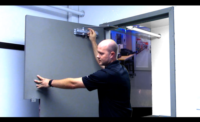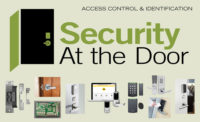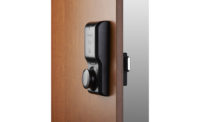They say that hindsight is 20/20. So as we go into the year 2020 it seems fitting to reflect back, while at the same time looking ahead at the most influential trends that shaped — or will shape — the security lock and door hardware market.
While everyone’s experience was slightly different, some trends begin to emerge when you consider the overall shape of the security market over the past 10 years. IP, wireless, IoT and Bluetooth are just a few of the technologies that have shifted the security space. These technologies will radically shift the security lock space, says Nick English, national sales manager, Kwikset, Lake Forest, Calif.
“Down the path I think you will see major innovations in electronic locks, probably to the point where we won’t even recognize what we have today,” he says. He points to embedded cameras, different power technologies, biometrics, Bluetooth, Wi-Fi and Z-Wave as prime examples. “It will be a melding of all these together,” he predicts. “Consumers continue to want everything merged.”
What Generated the Most Buzz?
SDM asked manufacturers of security locks and hardware what product generated the most buzz in the past year?
Brian Storrie, assistant vice president of product management for electronic access and data, dormakaba, Indianapolis, adds that simplicity has become an expectation for consumers and will continue to be of great importance. “One key trend we see is the ease-of-use and simplicity for the end user. A growing and continuing trend is to leverage BLE and mobile devices. Use of smartphones is growing year over year and we see that continuing because it brings ease of use to the customer.”
Storrie also points to intelligence and connected solutions as a continuing trend. “Rather than a discreet single purpose, the trend is that these devices will evolve and become part of a total urban solution, providing intelligence that will bring superior performance and benefits to the application and the consumer,” he said.
Locks are not just about risk mitigation anymore, explains Robert Gaulden, director, technology alliances, multi-family at Allegion, Carmel, Ind. “They have moved to the front of solutions aimed at solving pain points around access and experiences. This is creating a new way to look at ROI on smart locks and access control,” he says.
Bill Smoyer, national sales manager, Access Hardware Supply, San Leandro, Calif., has three predictions for the coming year, based on these and other trends. “Mobile credentials will continue to increase in sales due to demand, convenience and reduction of lost or forgotten cards; wireless locks will continue to increase in popularity; and sales will continue to increase for smart cylinders ... [which] allow for cost-effective deployment of security for end users with remote buildings and gates and allows compliance with new regulations.”
Read on to see what these and other experts think have been the biggest changes to the market in the past decade and how to prepare for what is coming in the next one.
A Changed Market
The residential lock and door hardware market probably experienced the most dramatic changes over the past decade, but the commercial side had some pretty significant shifts, as well.
“If you look back, electronic door locks started as a battery-operated touchpad,” English says of the residential market. “That evolved to connected products as part of a larger network, and finally [recently] to access through an app.” The whole connected, or smart home, trend has changed the role of the residential lock and made it an integral part of the home, he adds.
“Ten years ago, if you told people, ‘We can make that door lock electronic,’ they would have said, ‘Why would I need that?’ Now it is, ‘What else can you do with it?’”
Peter Boriskin, chief technology officer, ASSA ABLOY Opening Solutions Americas, New Haven, Conn., says these trends have been influential in shaping the commercial market, as well, particularly in the campus and multi-family housing verticals. “Mobile adoption has been increasing steadily over the last decade, with significant milestones in 2019,” he says. “Growing capabilities in the residential space continued to drive customer expectations in the commercial space. Apple’s launch of mobile student IDs played a significant role in this shift.”
On the commercial side, the biggest changes have come to the small and medium business (SMB) and school security markets — and wireless locks have opened the market for interior doors in many applications.
“In the past decade, what has really transpired has been in a particular vertical: K-12 and universities,” Storrie says. “If you look at the full decade, government spending and grants have caused true change in the marketplace. That has influenced our product development toward meeting that need. Yes of course there has been more IoT, more intelligence and less mechanical. But this is the trend behind that and something we are addressing.”
William Sporre, senior vice president of sales, Alarm Lock-Marks USA, divisions of Napco Security Technologies, Amityville, N.Y., also points to this trend. “I have worked with Marks for 35 years and in the past mechanical locks were exclusively used throughout schools because access control was cost-prohibitive … Just in the last part of this past decade access control locksets have come down in cost and made schools realize that the cost and availability of access control is a lot better going into the future.”
A lot of this revolves around the unfortunate need for lockdown capabilities, as school and other public mass shootings continue across the U.S., Sporre adds. “It is trending to where almost everywhere the public is they want lockdown capabilities. They are all concerned about safety.”
This has also led to a trend of interlocked vestibules in schools, as well as places of worship, says Bryan Sanderford, national sales manager, Dortronics Systems Inc., Sag Harbor, N.Y. “Interlocked vestibules are becoming integrated into the access system to provide an opportunity for verification of credentials and authorizing individuals for access into the facility.”
The wireless lock market has been particularly strong in schools and universities, but has also expanded to many other commercial applications. This has led to a situation where security integrators — who in the past never touched the hardware locks — are increasingly expected to know how to install these products. Companies such as ASSA ABLOY and others have increased their training in recent years to teach this skill.
While many security integrators started the decade resistant to this trend, consumer demand has increased to the point where this trend will continue into the next decade.
2020 Predictions
Mobile credentials and wireless locks are predicted to be the big news in 2020 by many of the experts.
“Mobile credentials will continue to increase in use due to convenience and savings on lost credentials,” Smoyer says. “The commercial industry is affected by the residential and consumer experience.”
Jim Primovic, director of campus EAC sales for ASSA ABLOY Opening Solutions Americas, says, “Many campuses updated their infrastructure to support mobile credentials. In 2020 and beyond, we expect to see broader deployment of mobile across all points of campuses. Furthermore we’ll see how integrated building information systems can provide the analytics needed for preventive measures and maintenance.”
Gaulden adds, “The mobile credential will gain traction in usage and deployment, especially in markets where IoT and technology disruption is happening. Take the multi-family vertical, for example. Self-tour, short-term rentals, package delivery — all these pain points are easier to solve with a mobile credential.”
Rob Lydic, vice president of PACS OEM business at Allegion, says the recent Apple Mobile launch will have a major impact in 2020. “The higher education market will move rapidly to the Apple Mobile credentials. These mobile credentials allow for secure access to facilities, secure financial transactions for books, meals, laundry and superior administration by the institution.”
On the residential side, mobile control of residential locks via Bluetooth is also set to become a driver within the market, says Matt Lukasiewicz, vice president marketing North America, ADI Global Distribution, Melville, N.Y. “Demand for the end user will likely drive the development of products that provide more streamlined and consolidated whole-home control.”
Mobile will also be influential in the commercial and industrial sectors, Boriskin says. “Users want the same seamless experience they enjoy at home to translate to their experience with products in the commercial and institutional setting. Mobile credentials address the growing demand for convenience and security.”
Wireless locks have been growing in interest throughout the past decade, and are really coming into their own this year, says David Price, vice president, communications and corporate development, Camden Door Controls, Mississauga, Ontario, Canada. The next phase is battery-free, he says. “No-battery wireless devices will gain in popularity as their performance is proven over hundreds or thousands of installations. We will also see more PoE-powered locking hardware being introduced to the market.”
Another trend that is starting to generate a lot of buzz (see sidebar on page 51) are solutions that make it easy to convert a mechanical lock into an electronic one. A number of manufacturers have recently introduced or plan in the first quarter of 2020 to announce their offerings.
For example, Kwikset recently brought out a product that takes the existing door lock and converts the interior to an electronic lock, English explains.
A relative newcomer to the market, Nexkey does something similar on the commercial side, with an “e-cylinder” that retrofits easily into any mechanical lock. “The Nexkey core is an electronic cylinder that you can put into any kind of lock and control it electronically,” says Eric Trabold, CEO of Nexkey, San Mateo, Calif.
dormakaba will release its Switch Tech at ISC West 2020, Storrie says. “Built around a small-format interchangeable core, we can replace that [mechanical] core, leaving the hardware on the door and within minutes make that a digital lock.”
CyberLock, Corvallis, Ore, puts a different spin on the core, says Director of Sales John Moa. “We put together a system that includes the cylinder, which is different than the lock housing. It has intelligence in it, but no power. On the key side we have a fob with intelligence but also power… Now you can pull the mechanical cylinder, put ours in, then just program locks and keys and update who has been where virtually in real time.”
Napco, too, has been leveraging its mechanical and digital divisions in a different way to achieve a similar result, Sporre says. “As a company we see Napco has married the access control with the mechanical and come out with products that we feel will be the future, combining mechanical locks with access control systems.” This solution requires taking the mechanical lock out and replacing it with a wireless lock, allowing for easier school lockdown, for example, and other electronic access benefits, he says.
The Electronic Decade
Over the next decade, predictions range from the growing influence of Wi-Fi and smartphones to AI and smart buildings. But all agree that the mechanical to electronic shift will continue in a dramatic way.
“The growing number of products with Wi-Fi capabilities will drive significant change in the market,” Lukasiewicz says. “Wi-Fi-enabled devices integrate with smart home systems much easier than those which leverage older technologies such as Z-Wave. As the demand for smart home solutions grows, Wi-Fi-enabled locks and hardware are emerging as an easy addition to a whole-home system that more dealers can leverage to upsell their customers.”
English agrees. “Wi-Fi will have more impact. New home builders are gravitating towards that … Everyone will have a Wi-Fi router.”
Gaulden says the influence of the mobile phone will only grow in the next decade. “In general, the mobile phone and how it is utilized as an enabler in this space will have the most impact. There is so much power in the device, from being able to be a credential, to an intercom, to a processer, to a provider of an experience (through an app). The mobile phone’s impact is still being defined.”
Mobile credentials will continue to expand their user and the next iteration will be Ultra Wideband (UWB), Boriskin predicts. “UWB will enable hands-free access to entry and exit points. It can decipher whether a credential holder is simply walking by a door or is actually walking toward the door to enter.”
Jerry Burhans, managing director of ABLOY USA, Irving, Texas, says Bluetooth-based locks are just getting started, with the introduction in the past decade of cabinet locks and other non-door applications, the addition of Bluetooth will really open up the possibilities. “Once you start having the capability of Bluetooth technology on the networked enterprise platform for padlocks, camlocks and cabinet locks, the entire lock industry will change in regards to how a customer considers their purchases and deployment of locks,” he says.
One surprising prediction is that the artificial intelligence trend will reach the electronic locks and hardware space in the coming decade. “Today AI resides [mostly] in the video and analytics space,” Storrie acknowledges. “But tomorrow, anything intelligent will be contributing to that overall predictability … In the next decade we will be leveraging the data of everyday use and compiling it into cloud computing, intelligent modeling and overall system improvements and benefits. How many times did you access that door? What times? How do users typically behave?”
Trabold predicts that in the next decade and beyond most locks will be electronic. “In 15 years 75 percent of locks will be electronic in some form. That will be the future. The adoption of mobile and cloud will also dramatically increase. If a new employee joins the workforce in 10 years and you tell them we used to have a credential, they will say, ‘That sounds so inconvenient!’ They will be able to just walk through the door.”
For security integrators, Boriskin offers this advice for the coming decade: “Have an open mind. The biggest changes in 2020 and certainly the next decade will require a different mindset when it comes to security. Access control is no longer about who gets into and out of an opening. It’s about what happens at the opening and how. Access control is security, convenience and much more. Users want a seamless experience, and business and institutions want to optimize all facets of their operations.”
More Online
For more on security locks and door hardware visit SDM’s website, where you will find the following articles.
“Smarter Intelligent Locks and Hardware for the Intelligent Age”
www.SDMmag.com/smarter-intelligent-locks-for-the-intelligent-age
“How Distributors Can Help You Sell More Security Locks & Hardware”
www.SDMmag.com/how-distributors-can-help-you-sell-more-security-locks-hardware
“Entry Control: The Product With a Lot of Traction”
www.SDMmag.com/entry-control-the-product-with-a-lot-of-traction
“The State of the Access Control Market in 2019”
www.SDMmag.com/the-state-of-the-access-control-market-in-2019





